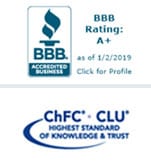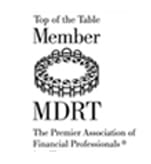
The best retirement plans let you hope for the best and prepare for the worst. From stock market free-falls to soaring inflation, there are five major retirement risks that your retirement plan must be ready to handle. In this article, we explore each risk, as well as strategies you can use to keep your nest egg safe.
Investment
Investor, beware! As you approach retirement, your ability to weather stock market lows will sharply decrease. In fact, how the market performs in the last three years of your career and the first five of your retirement has an outsized impact on your savings. Not only do you have less time to recover from market downturns, but as you take withdrawals for income, less money remains invested in the account to help you recover. If several years of negative returns occur during this crucial early retirement period, your savings could run out far sooner than planned. This is called sequence of returns risk.
The best defense against sequence of returns risk is to house at least part of your savings in an account that is not vulnerable to stock market losses. Doing so allows you to strategize your withdrawals so that in years with negative returns, you only withdraw income from your safe account. In volatile markets, multiple accounts can be a lifesaver. Ideally, your safe account should also maximize earnings—a tall order for traditional risk-free options such as savings accounts and CDs. Fixed index annuities are a popular, zero-risk alternative with a higher earnings potential than your garden-variety savings account, although they aren’t for everyone. A financial advisor can help you determine if an annuity is in your best interest.
Inflation
The second law of thermodynamics tells us that the universe tends toward increased disorder. Similarly, the second law of inflation tells us that the universe tends toward increased prices—and also that in my day, a gallon of gas was only 25 cents. The average annual rate of inflation is about 3%. As a result, just to maintain the same lifestyle, your income will need to increase by at least 3% each year. When you live on a fixed retirement income, you can no longer depend on raises and promotions to keep your income stable. Without proper planning, inflation can easily eat away at your retirement savings, also known as inflation risk.
The first step to combating inflation risk is to calculate how inflation will impact your income needs over the course of your retirement. This calculator will help you determine how much income you will need five, ten, or even fifteen years from now. The next step is to find financial instruments that will either help you generate extra income or lower your expected costs. Stocks are a popular income-generator, while different Medicare and HSA plans can help you minimize your healthcare costs, which is the largest expense in retirement. Check out our full guide to inflation-proofing your retirement.
Long-Term Care
Second only to healthcare costs, long-term care is one of the greatest expenses most retirees encounter. We say “most” because about 70% of Americans require some form of long-term care, according to the Department of Health and Human Services. Depending on the level of required care, the monthly cost of long-term care services in the state of Connecticut ranges from $4,000-$14,000. The cost of long-term care is prohibitive for most retirees and can devour savings unless a contingency plan is put in place.
What is that contingency plan? For many, there are only two options for funding long-term care: paying out of pocket or long-term care insurance. If adding $48,000 or more to your annual expenses is a nauseating prospect (as it is for most of us), we suggest investing in a robust long-term care insurance policy.
Taxes
Income, interest, capital gains, and certain dividends are all subject to various tax rates. Taken as an aggregate, these taxes can get in the way of a stable and sufficient income, specifically because most people fail to take them into account while planning their retirements. Understanding how your income and assets are taxed can help you predict how much of your nest egg will end up in your pocket after Uncle Sam fills his own.
Once you have a read on your estimated tax burden, you can take steps to reduce it. Year-end and year-round tax planning allow you to leverage different strategies, such as capital loss harvesting, tax-deferral, and Roth conversions, in order to shrink your tax bill. With the help of a tax professional, you can determine which tax-reduction methods make sense for your specific situation. Then, in the lead up to April 15th, get in touch with a trusted tax preparer. While some of us may take preparing our own tax returns for granted, CPA’s and Enrolled Agents are quite literally certified in preparing returns that save you, the taxpayer, the maximum amount of money.
Outliving Your Income
As a concept, retirement is a fairly recent development in human history. It was Otto von Bismark, the minister president of Prussia, who first suggested in 1881 that citizens over age 70 should receive financial support from the government. The idea was wildly popular since it offered an alternative to the most common retirement plan: working until you died. When Franklin Roosevelt imported von Bismarck’s idea to the U.S. in 1935, he lowered the qualifying age to 65. We now call this program Social Security. At the time, however, the average life expectancy was only 60 (for men) and 64 (for women). Now the average life expectancy is about 78.5 years—almost two more decades that Americans have to save for. What happens if you save enough for 20 years of retirement but end up living for 30 or 40?
Outliving your retirement income is called longevity risk. There are several strategies you can use to outwit the clock. The most important is to maximize your social security benefit, a guaranteed income stream. Many Americans mistakenly believe that 62 is the right age to claim social security. However, unless you are disabled, sick, or need the money immediately, we suggest waiting until you reach full retirement age—66 or 67 depending on the year you were born. If you claim your benefit before full retirement age, your social security income will be permanently reduced. Additionally, every year after full retirement age, up until age 70, that you delay claiming will bump your monthly benefit by an additional 8%. At our office, we offer free social security maximization consultations to help you determine the best way to file for your benefits.


Sara McKinney
saractag@gmail.com
As Cowen Tax Advisory Group’s Digital Content Marketing Specialist, Sara provides in-house copywriting and manages the company’s electronic records system, email marketing, and blog.




